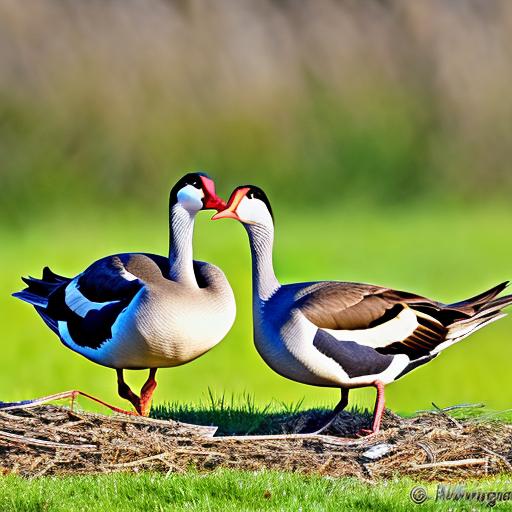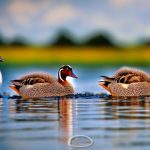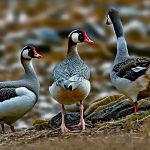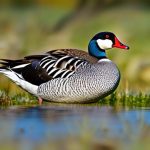Breeding geese is a rewarding and fulfilling endeavor that requires careful consideration and planning. Whether you are breeding geese for meat, eggs, or conservation purposes, selecting the right breeding pair is crucial for the success of the breeding process. Breeding geese involves understanding their behavior, selecting healthy and genetically diverse geese, and providing them with suitable housing and feeding conditions. In this article, we will explore the importance of selecting the right breeding pair of geese and provide tips and best practices for successful breeding.
Key Takeaways
- Selecting the right breeding pair of geese is crucial for successful breeding.
- Understanding the breeding behavior of geese can help in selecting the right pair.
- Factors to consider when selecting a breeding pair include age, health, and genetic diversity.
- Proper housing and feeding are important for preparing geese for breeding season.
- Monitoring breeding process and incubating goslings require attention to detail and best practices.
Importance of Selecting the Right Breeding Pair of Geese
Selecting the right breeding pair of geese is essential for the success of the breeding process. The genetic makeup of the breeding pair will determine the quality and characteristics of their offspring. By choosing geese with desirable traits, such as good meat or egg production, you can ensure that the next generation will inherit these qualities. Additionally, selecting genetically diverse geese will help prevent inbreeding and maintain a healthy population.
Furthermore, the health of the breeding pair is crucial for successful breeding. Healthy geese are more likely to produce healthy offspring and have a higher fertility rate. It is important to carefully examine potential breeding geese for any signs of illness or disease before selecting them as a breeding pair. Regular veterinary check-ups and proper nutrition are also essential to maintain the health of the breeding pair.
Understanding the Breeding Behavior of Geese
To successfully breed geese, it is important to understand their natural breeding behavior. Geese are monogamous birds that form strong pair bonds. They typically mate for life and will only seek out a new partner if their mate dies. During the breeding season, which usually occurs in spring, geese become more territorial and protective of their nesting area.
Geese display various courtship behaviors to attract a mate. These behaviors include head bobbing, neck stretching, and honking. Male geese, known as ganders, will often chase and display aggression towards other males to establish dominance and win the attention of a female goose, known as a goose. Once a pair has formed, they will engage in preening and mutual grooming to strengthen their bond.
Factors to Consider When Selecting a Breeding Pair of Geese
When selecting a breeding pair of geese, there are several factors to consider. Firstly, the age of the geese is important. It is generally recommended to select geese that are at least two years old for breeding. Younger geese may not have reached sexual maturity and may not be ready to breed.
Temperament is another important factor to consider. Geese with aggressive or overly timid temperaments may not be suitable for breeding. It is important to select geese that are calm, docile, and easy to handle. This will make the breeding process easier and reduce stress for both the geese and the breeder.
Additionally, it is important to consider the desired traits in the offspring when selecting a breeding pair. If you are breeding geese for meat production, you may want to select geese that have good meat quality and growth rate. If you are breeding geese for egg production, you may want to select geese that have good egg-laying abilities. By selecting geese with desirable traits, you can improve the quality of your flock over time.
Preparing for Breeding Season: Housing and Feeding Geese
To ensure successful breeding, it is important to provide a suitable environment for your geese. Geese require adequate space to roam and graze. A spacious enclosure with access to fresh water and grassy areas is ideal for breeding geese. It is important to provide shelter from extreme weather conditions and predators.
Feeding your geese a balanced diet is crucial for their overall health and fertility. During the breeding season, geese require a diet that is high in protein and calcium to support egg production. Feeding them a mix of grains, greens, and commercial poultry feed can help meet their nutritional needs. It is important to provide fresh water at all times and ensure that the feed is free from contaminants.
Monitoring the Breeding Process: Signs of Successful Breeding

Monitoring the breeding process is important to ensure that your geese are successfully breeding. One of the first signs of successful breeding is the formation of a pair bond between the gander and the goose. They will display courtship behaviors and spend more time together.
Another sign of successful breeding is the presence of a nest. Geese typically build their nests on the ground, usually in a secluded area near water. The female goose will lay her eggs in the nest and incubate them until they hatch. It is important to provide nesting materials, such as straw or grass, to encourage nest building.
Incubating and Hatching Goslings: Best Practices
Once the eggs are laid, you have the option to let the female goose incubate them or use an artificial incubator. If you choose to let the female goose incubate the eggs, it is important to provide a quiet and secure area for her to do so. The incubation period for goose eggs is approximately 28-30 days.
If you choose to use an artificial incubator, it is important to follow the manufacturer’s instructions for temperature and humidity settings. Turning the eggs regularly during incubation is also important to prevent the embryos from sticking to the shell.
Once the goslings start hatching, it is important to provide them with a warm and safe environment. A brooder box with a heat lamp can provide the necessary warmth for the goslings. It is important to monitor their temperature and adjust the heat lamp accordingly. Providing clean water and a balanced diet is also crucial for their growth and development.
Raising Goslings: Feeding, Care, and Socialization
Raising goslings requires proper care and attention. It is important to provide them with a balanced diet that meets their nutritional needs. A starter feed specifically formulated for goslings is recommended. It is important to provide fresh water at all times and ensure that the feed is free from contaminants.
Goslings require socialization to develop into well-adjusted adults. It is important to handle them gently and spend time with them regularly. This will help them become accustomed to human interaction and reduce stress when they are older.
Common Challenges in Breeding Geese and How to Overcome Them
Breeding geese can come with its own set of challenges. One common challenge is infertility. Infertility can be caused by various factors, such as age, health issues, or genetic problems. To overcome infertility, it is important to ensure that the breeding pair is healthy and well-nourished. Regular veterinary check-ups can help identify any underlying health issues that may be affecting fertility.
Another common challenge is disease. Geese are susceptible to various diseases, such as avian influenza and botulism. It is important to practice good biosecurity measures, such as regular cleaning and disinfection of the enclosure, to prevent the spread of disease. Vaccinations and regular veterinary check-ups can also help prevent and manage disease outbreaks.
Benefits of Breeding Geese for Meat, Eggs, and Conservation Purposes
Breeding geese can have numerous benefits, both for personal use and conservation purposes. Breeding geese for meat can provide a sustainable source of high-quality meat that is lean and flavorful. Geese are known for their delicious meat, which is often compared to beef or duck.
Breeding geese for eggs can provide a sustainable source of fresh and nutritious eggs. Goose eggs are larger than chicken eggs and have a rich and creamy flavor. They are often used in baking and cooking.
Breeding geese can also contribute to conservation efforts. Many goose species are threatened or endangered due to habitat loss and hunting. By breeding geese in captivity, you can help maintain healthy populations and contribute to their conservation.
Selecting the right breeding pair of geese is crucial for successful breeding. By understanding the breeding behavior of geese, selecting healthy and genetically diverse geese, and providing suitable housing and feeding conditions, you can increase the chances of successful breeding. Breeding geese can be a rewarding and fulfilling endeavor, whether it is for meat, eggs, or conservation purposes. Consider breeding geese for your own purposes and enjoy the benefits that come with it.
If you’re considering adding a breeding pair of geese to your flock, it’s important to provide them with a suitable living environment. A well-designed chicken coop can also serve as a comfortable home for geese. In fact, the Poultry Wizard website offers a helpful article on creating a garden chicken coop that is perfect for both chickens and geese. This article provides valuable insights on how to design and set up a coop that meets the needs of your feathered friends. To learn more about this topic, check out the article here.
FAQs
What is a breeding pair of geese?
A breeding pair of geese refers to a male and female goose that are kept together for the purpose of producing offspring.
How do you identify a male and female goose?
Male geese, also known as ganders, are typically larger in size and have a more prominent neck and head. Female geese, also known as geese, are usually smaller and have a less pronounced neck and head.
What is the breeding season for geese?
The breeding season for geese typically occurs in the spring, from March to May.
How many eggs do geese lay?
Geese typically lay between 5 to 12 eggs per clutch, with an average of 7 eggs.
How long does it take for goose eggs to hatch?
It takes approximately 28 to 30 days for goose eggs to hatch.
What is the lifespan of a goose?
The lifespan of a goose can vary depending on the species, but on average, they can live up to 20 years in the wild and up to 30 years in captivity.
What is the purpose of breeding geese?
Breeding geese is often done for the purpose of producing meat, eggs, or for ornamental purposes. Some people also breed geese for conservation purposes to help preserve certain species.
Meet Walter, the feathered-friend fanatic of Florida! Nestled in the sunshine state, Walter struts through life with his feathered companions, clucking his way to happiness. With a coop that’s fancier than a five-star hotel, he’s the Don Juan of the chicken world. When he’s not teaching his hens to do the cha-cha, you’ll find him in a heated debate with his prized rooster, Sir Clucks-a-Lot. Walter’s poultry passion is no yolk; he’s the sunny-side-up guy you never knew you needed in your flock of friends!







